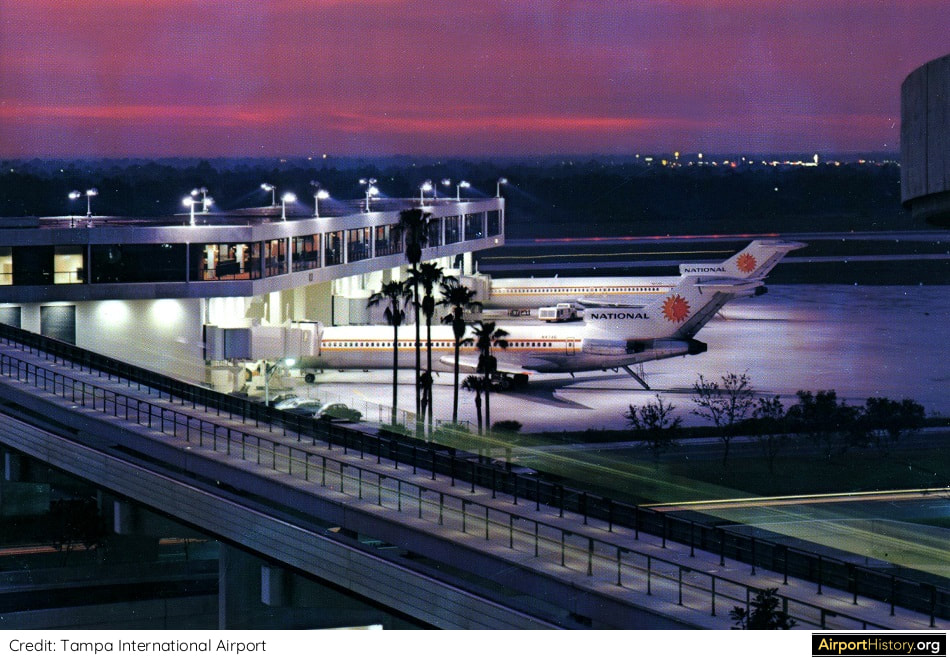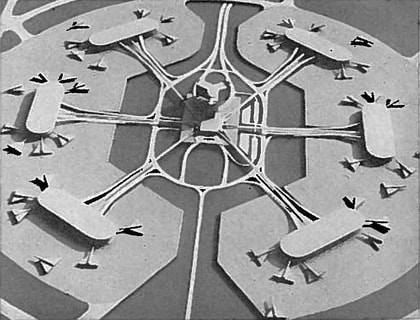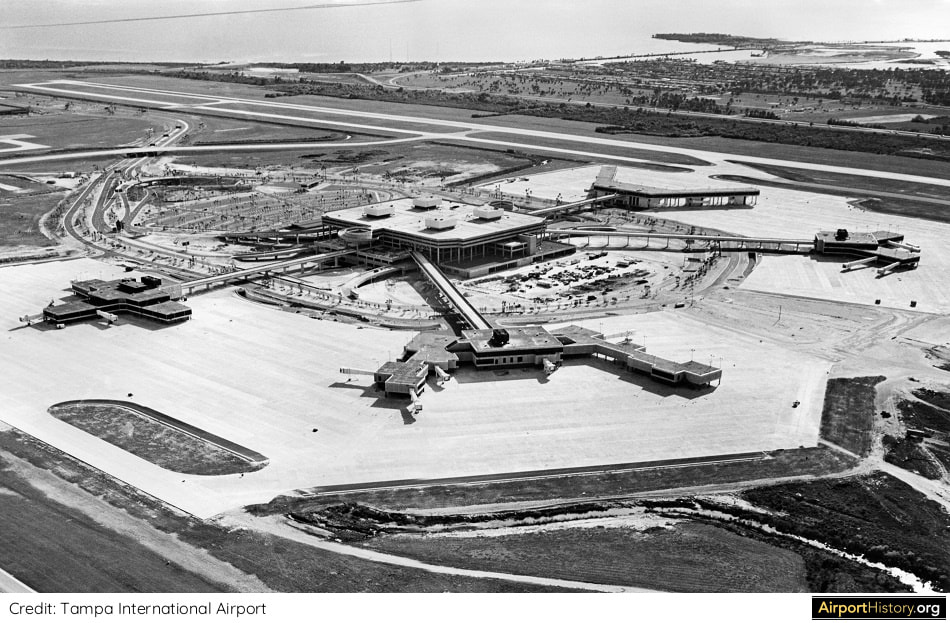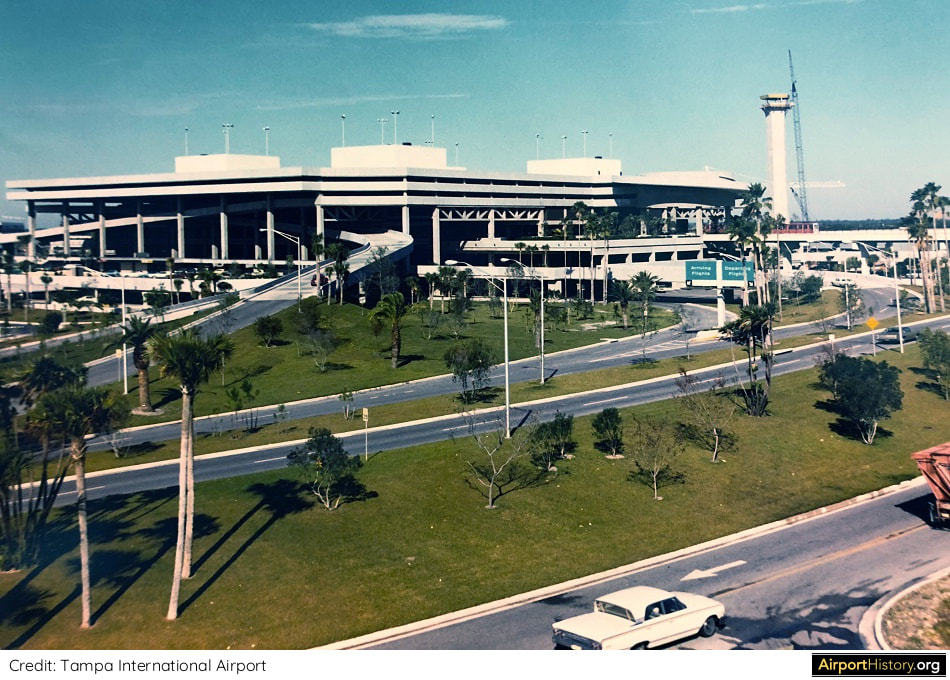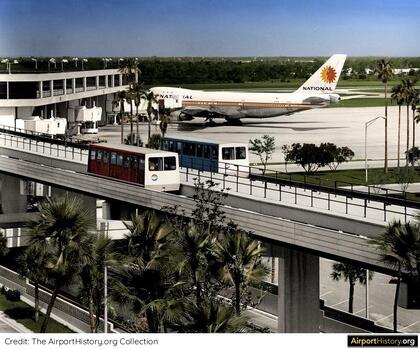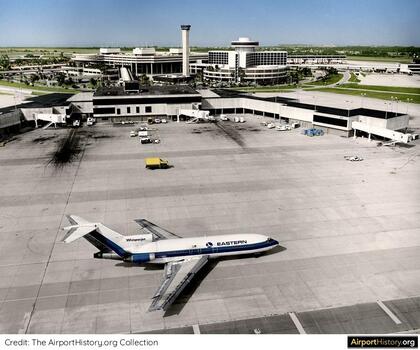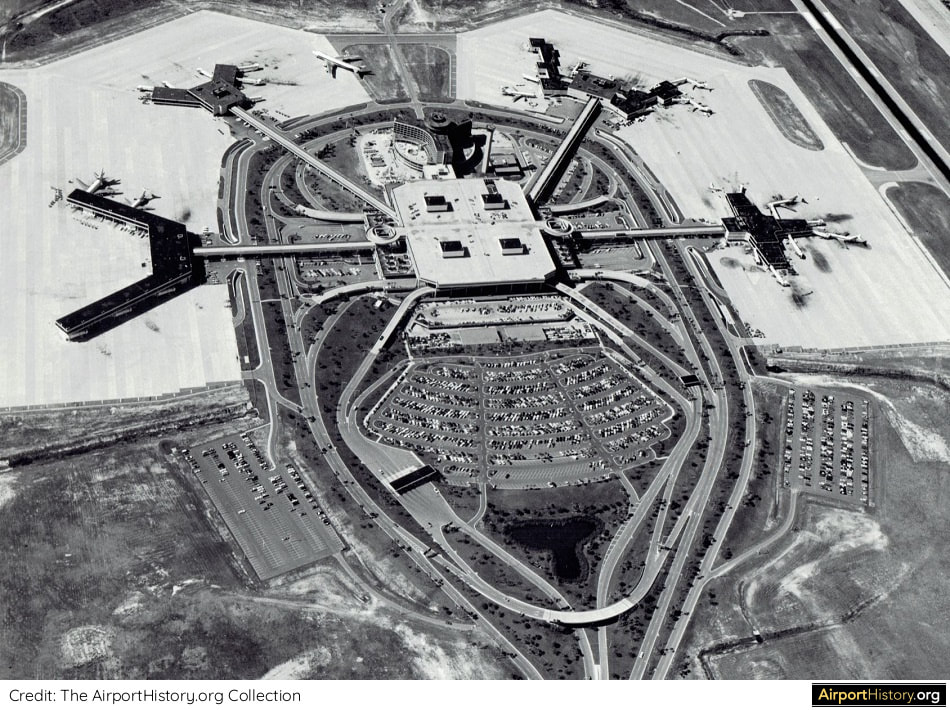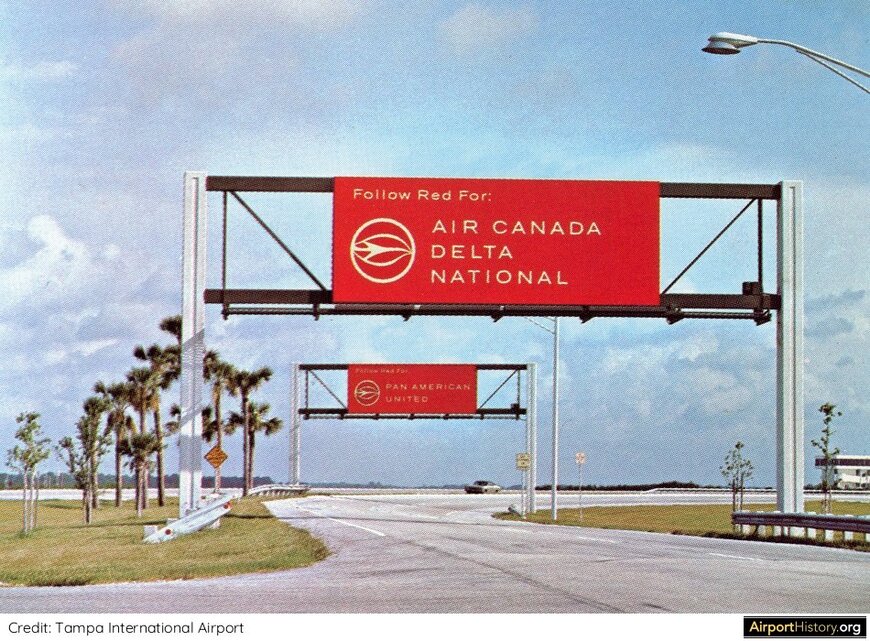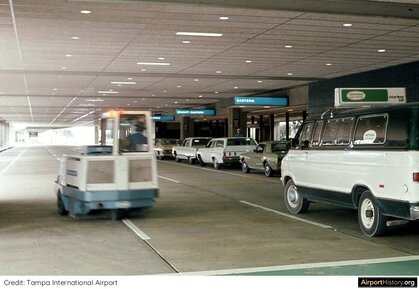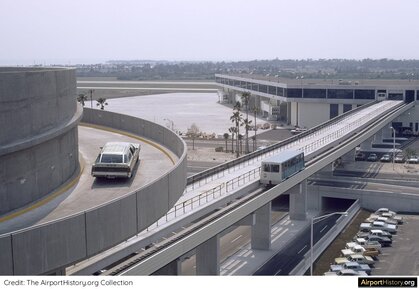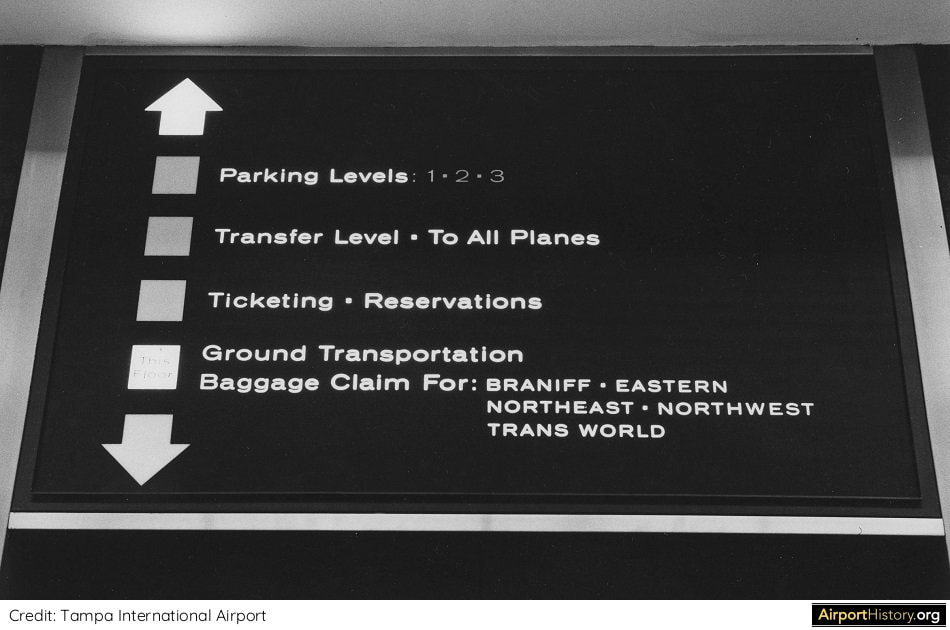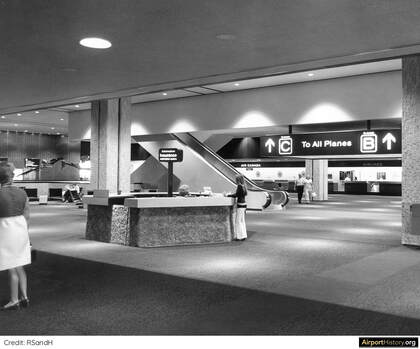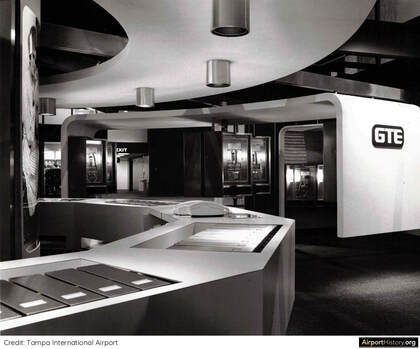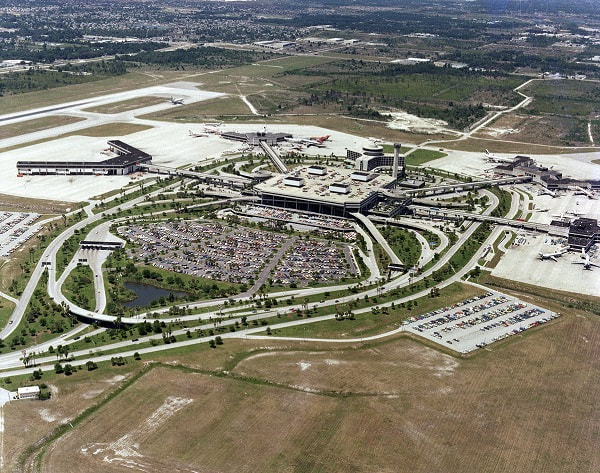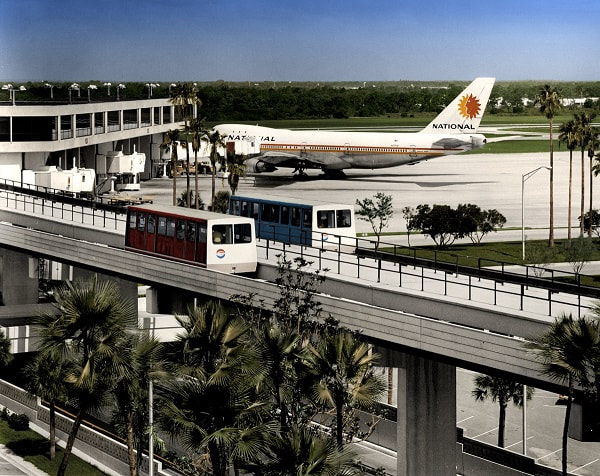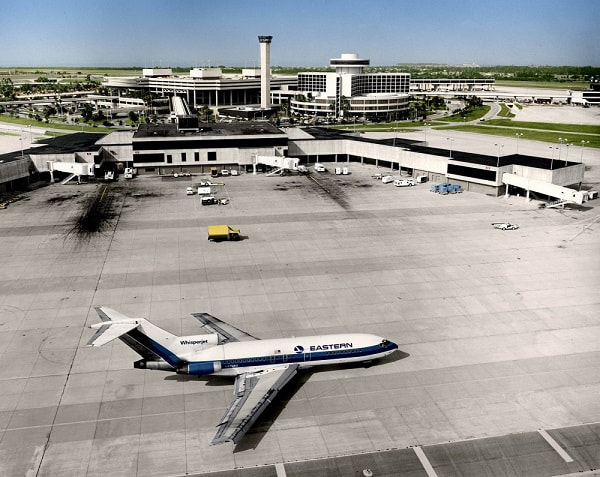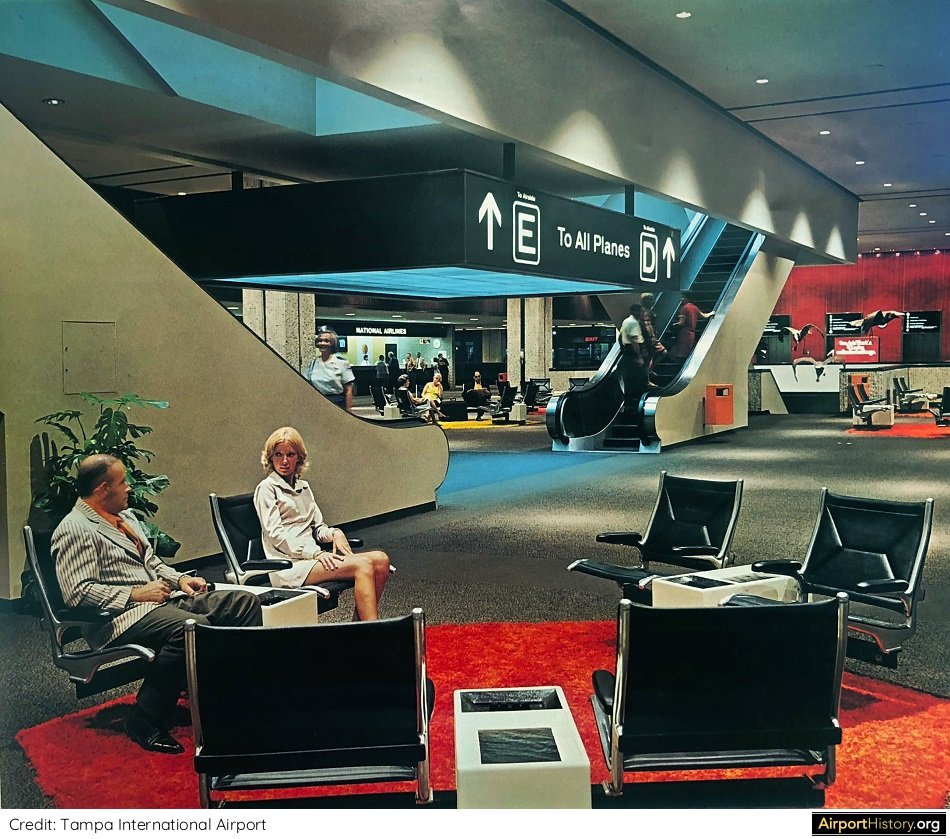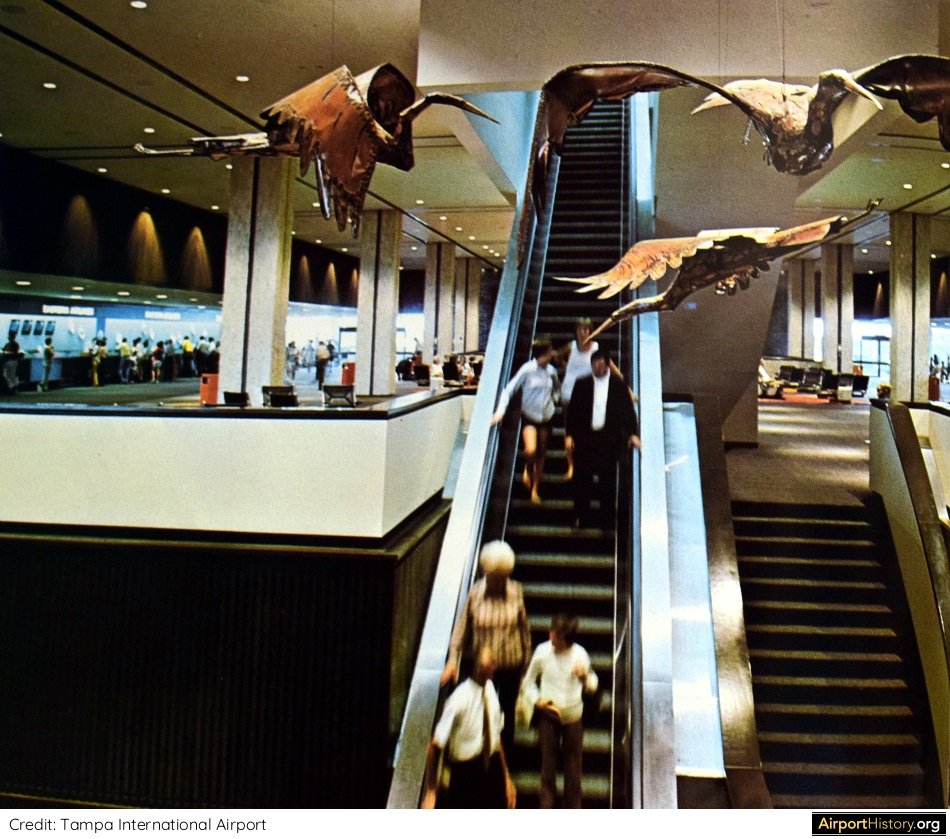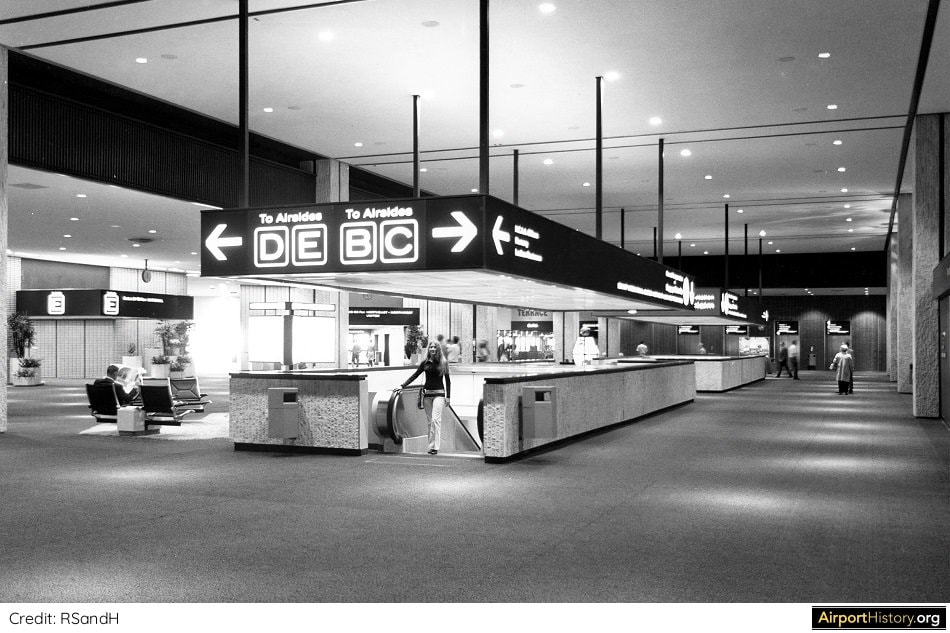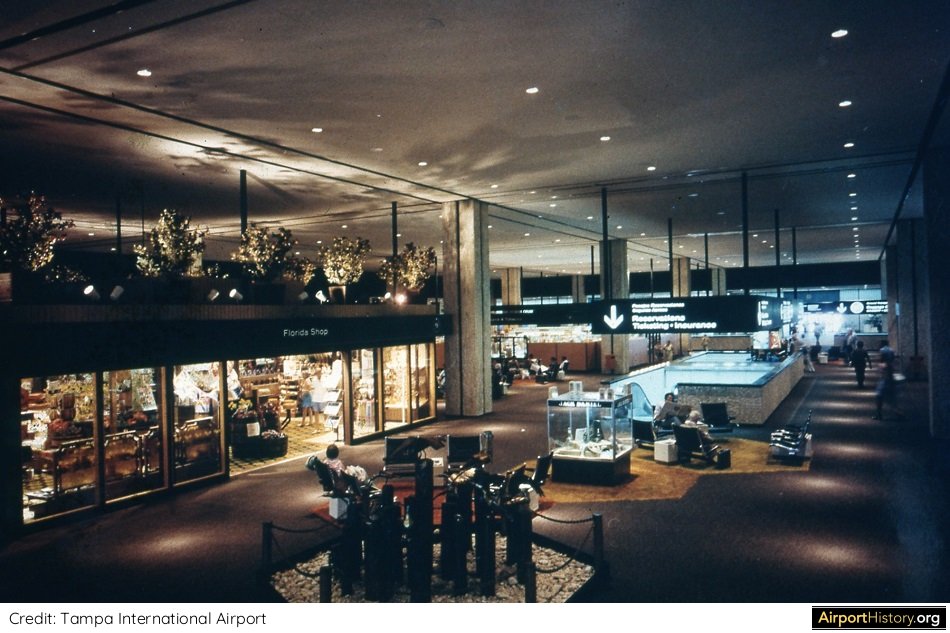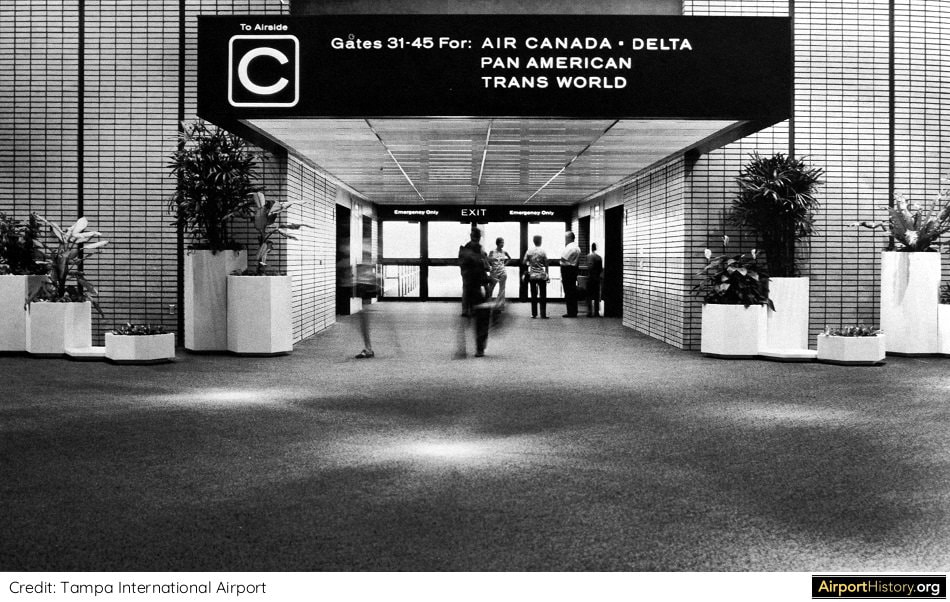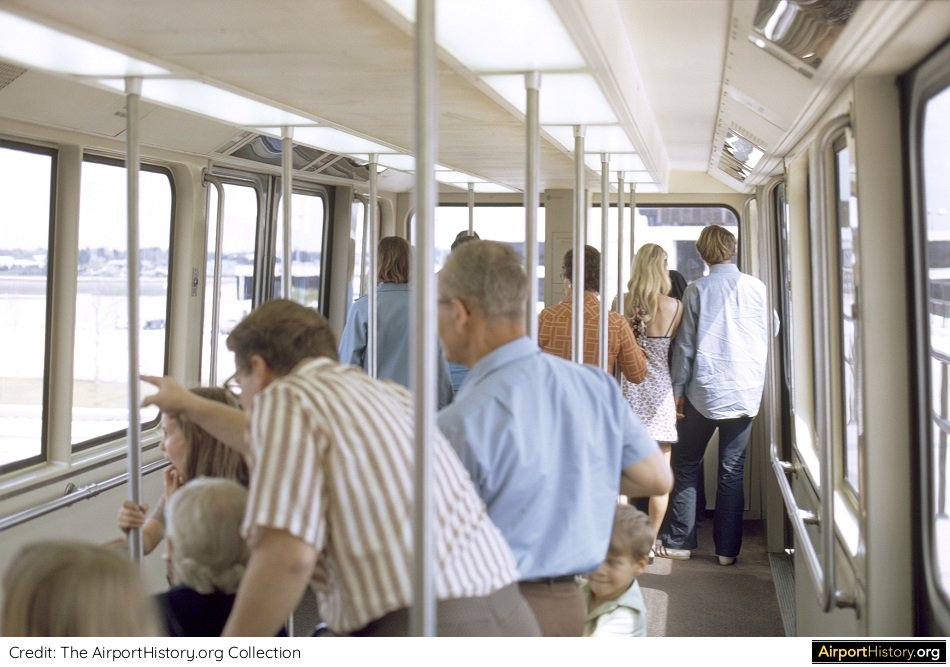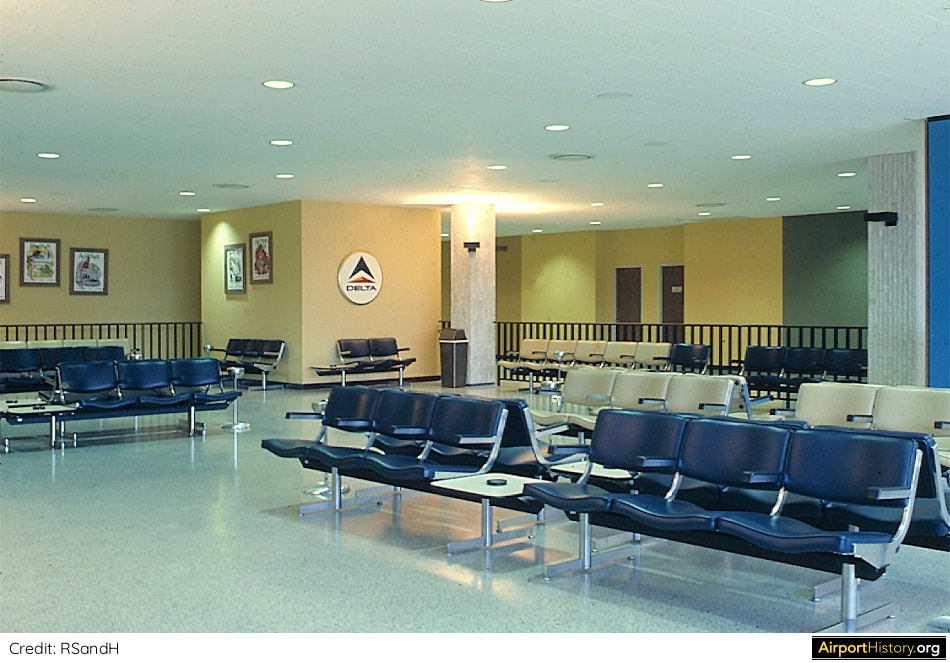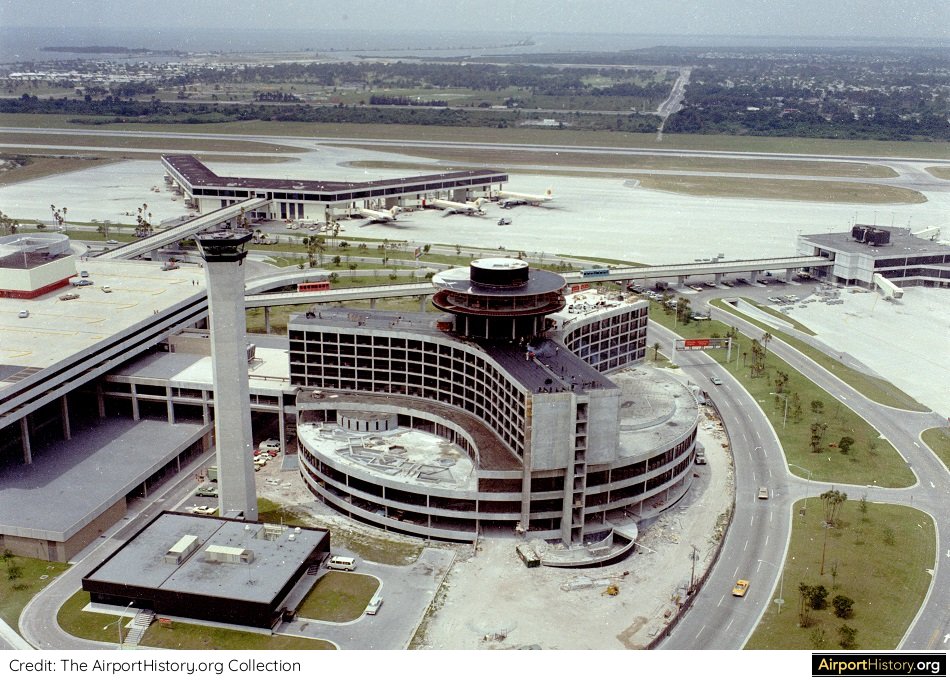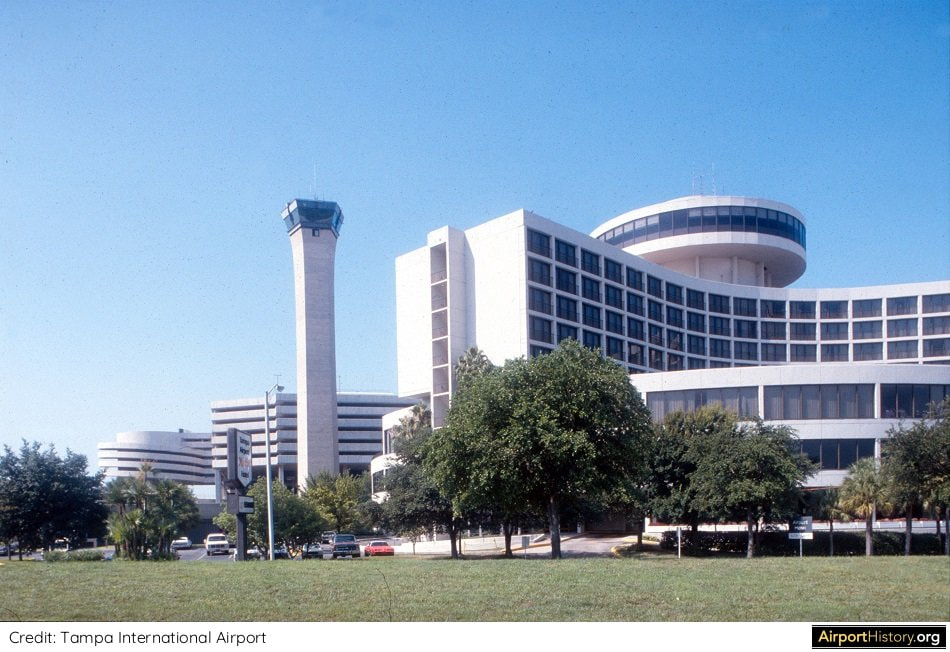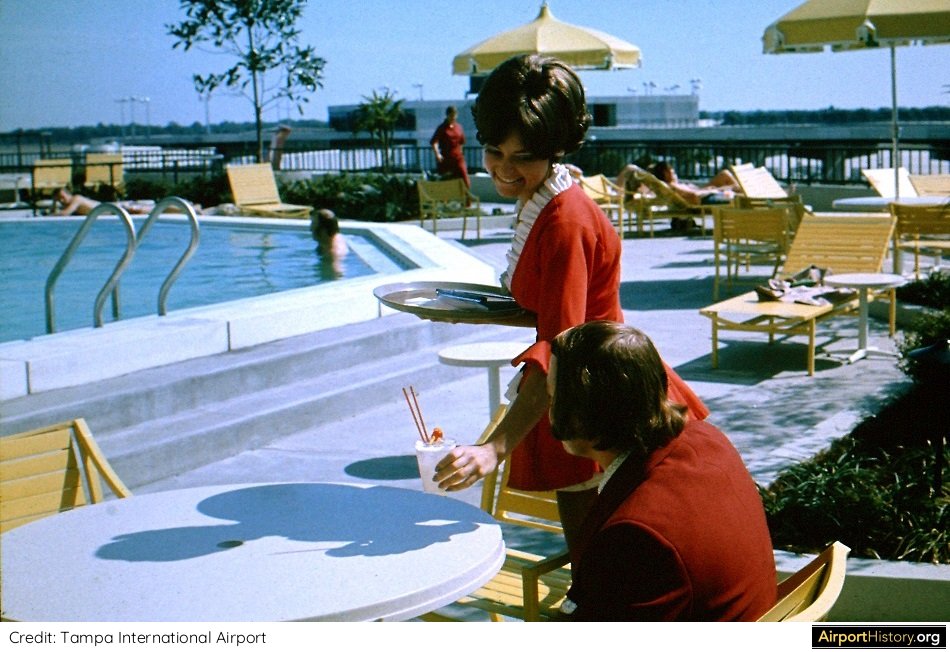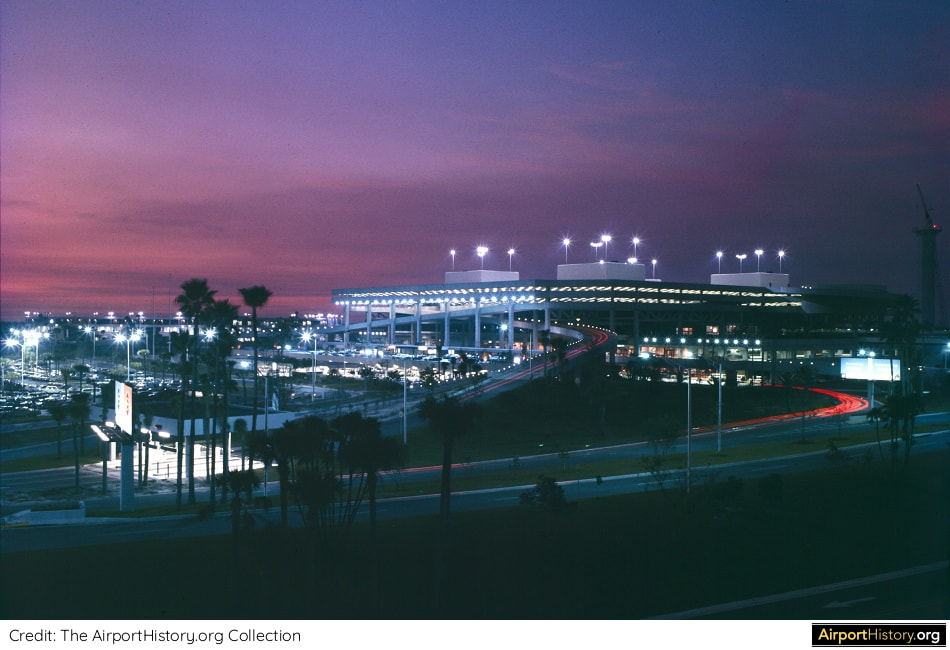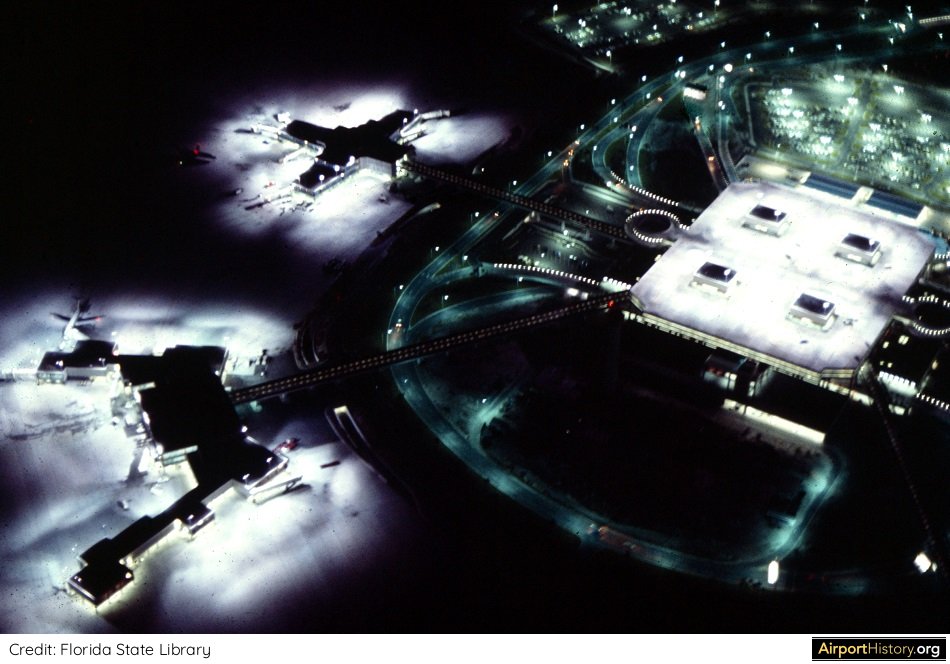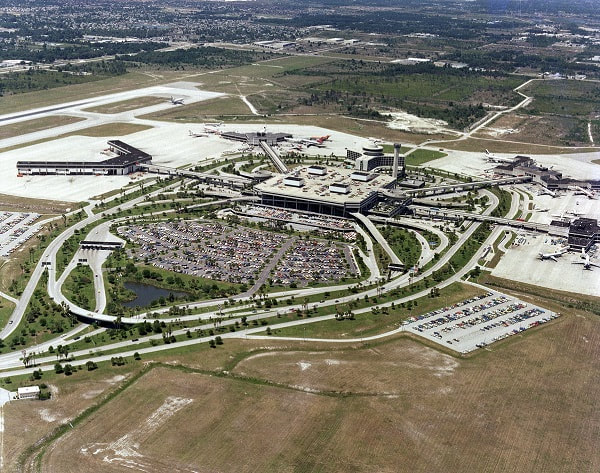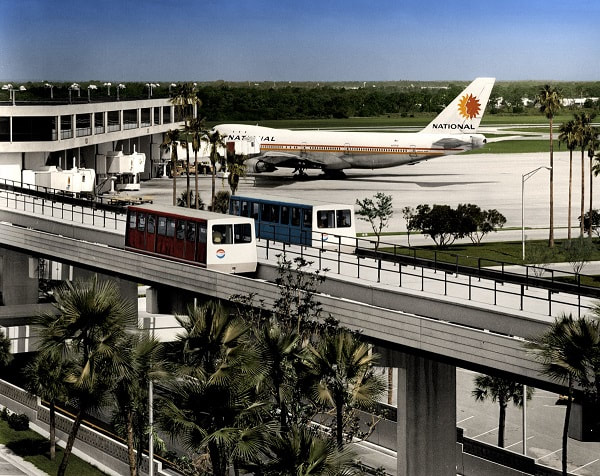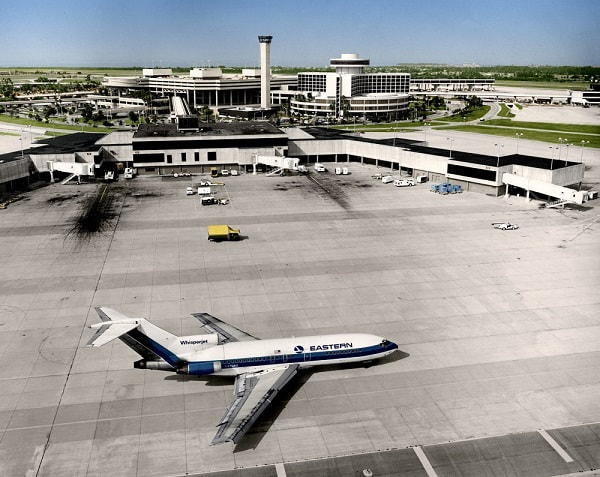Published: April 14, 2021
It will have been 50 years ago this month that Tampa's Jet-Age terminal was inaugurated. The complex has aged very well and today Tampa is still considered one of America's favorite airports. In this photo special, we look back at the terminal in its early years!
A Jet-Age terminal for Tampa
|
In 1962, traffic at Tampa International Airport passed the one million passenger mark for the first time. Hillsborough County Aviation Authority started thinking about building a modern Jet-Age terminal complex.
They had three design requirements: walking distances had to be kept very short, the terminal should be able to expand in an easy and modular fashion, and the ultimate capacity would need to be 20 million annual passengers. The chosen concept was called the Landside/Airside Terminal, which in its early incarnation resembled a snowflake. |
At the core was the main Landside Terminal, which contained parking, ticketing and baggage claim. The Landside building was surrounded by six Airside Satellites, where passengers could board the aircraft.
An automated people mover system would transport airline passengers between the Landside and Airside Buildings. Work on the terminal began on October 28, 1968.
An automated people mover system would transport airline passengers between the Landside and Airside Buildings. Work on the terminal began on October 28, 1968.
An aerial view of the completed terminal taken in March 1971. The USD 83-million complex opened on April 15th. The concept of identical airside buildings was abandoned and the main airlines operating out of Tampa (Delta, Eastern, National & Northwest) were allowed greater participation in the design process. The result was four distinctly different Airsides designed around the requirements of their tenants.
A 1971 view of the completed Landside Terminal. The six-story structure contained more than a million square feet of floor space. The building's foundation and supporting columns were designed for expansion and could ultimately support three additional levels of parking. These would be added in the early 1980s.
In this photo, the 227-foot-tall (69 meter) air traffic control tower is still under construction. It would be completed a year later on July 15th, 1972.
In this photo, the 227-foot-tall (69 meter) air traffic control tower is still under construction. It would be completed a year later on July 15th, 1972.
|
A National Airlines Boeing 747-100 is parked at Airside E, which was the largest of the airside buildings and exclusively used by the carrier. You can purchase a large, high-quality version of this image here.
|
An Eastern 727-100 is taxiing past Airside C. National and Eastern were the largest operators at TPA.
You can purchase a large, high-quality version of this image here. |
A 1973 aerial view looking north. Airside E (left) was exclusively assigned to National Airlines. Airside D (upper left) was assigned to Northwest Airlines, Northeast Airlines, and United Airlines. Note the Northwest 747 that just pushed back from the gate. In the early years, the carrier used the 747 on its route to Chicago O'Hare.
Airside C (upper right) was used by Air Canada, Delta, Pan Am, and Trans World Airlines. It was the only airside building to contain customs and immigration facilities. Airside B (right) had Eastern Airlines and Braniff International as the building’s primary tenants. The Airside was also home to commuter operators PBA/Naples and Shawnee Airlines.
Note that there was space provided to add two more airside buildings. Airsides F and A were added in 1987 and 1995 respectively.
Airside C (upper right) was used by Air Canada, Delta, Pan Am, and Trans World Airlines. It was the only airside building to contain customs and immigration facilities. Airside B (right) had Eastern Airlines and Braniff International as the building’s primary tenants. The Airside was also home to commuter operators PBA/Naples and Shawnee Airlines.
Note that there was space provided to add two more airside buildings. Airsides F and A were added in 1987 and 1995 respectively.
The passenger journey
The terminal and access roads were color-coded with blue and red symbols to assist travelers in finding airlines and other facilities as quickly and easily as possible. All the airlines serving the airport were assigned a color depending on their location within the Landside Terminal.
The blue airlines were located in the south side of the building and the red carriers were situated in the north. Did you know the TPA logo is based on an abstract design for a supersonic aircraft?
The blue airlines were located in the south side of the building and the red carriers were situated in the north. Did you know the TPA logo is based on an abstract design for a supersonic aircraft?
|
A view of the south curbside. The terminal was only the second one in the world--the first one being Houston Intercontinental--to boast two departure curbs on opposite sides of the terminal.
|
Driving up the ramp of the parking garage. The three parking levels contained a total of 1,800 short-term parking spaces. A shuttle train is moving from the Landside Terminal toward Airside E.
|
After parking passengers or meeters & greeters could take elevators down to one of three levels. Level one (Baggage Claim) contained fourteen T-shaped luggage dispensers, the baggage make-up area (where suitcases were sorted) and ground transportation services.
Level two (Ticketing) housed six ticket counter islands dedicated to baggage check-in and ticketing functions. Level three (Transfer) was where the shuttle stations were located and where restaurants and shops could be found.
Level two (Ticketing) housed six ticket counter islands dedicated to baggage check-in and ticketing functions. Level three (Transfer) was where the shuttle stations were located and where restaurants and shops could be found.
Checking in
A view of the Eastern Air Lines ticketing area. Travelers and the media praised the avant-garde new terminal. U.S. News and World Report wrote, “inside the terminal are vast expanses of carpeted waiting areas and softly lighted ticket counters – more like a quiet hotel lobby than the usual crowded airport departure lounge.”
|
Flight insurance booths were once a fixture in airport terminals around the world. The last booths disappeared in the late 1980s, as a result of improved aviation safety.
|
Something else that disappeared from terminals: public phones. This phone bank was sponsored by the General Telephone & Electronics Corporation.
|
Enjoying this article?
Sign up to our e-mail newsletter to know when new content goes online!
Get high-quality downloads of TPA for your collection!
Click below to download carefully restored photos or documents
Click below to download carefully restored photos or documents
An overview of the eastern side of the transfer level.
The middle of the transfer level contained a number of shops, including a duty-free shop, a news and tobacco shop, a toy shop and "the Florida Shop", which sold local items.
To the aircraft
Passengers are waiting for a shuttle train to take them to Airside C, which was the only airside building capable of handing international flights.
In the 1970s, Tampa only had a handful of international routes. Air Canada operated flights to Toronto's Pearson Airport. Pan Am operated a daily flight to Mexico City and four flights a week to Merida, also in Mexico. Flights to Europe began on May 4th, 1979, when National Airlines inaugurated nonstop McDonnell Douglas DC-10 flights to Amsterdam.
In the 1970s, Tampa only had a handful of international routes. Air Canada operated flights to Toronto's Pearson Airport. Pan Am operated a daily flight to Mexico City and four flights a week to Merida, also in Mexico. Flights to Europe began on May 4th, 1979, when National Airlines inaugurated nonstop McDonnell Douglas DC-10 flights to Amsterdam.
The Westinghouse People Mover System was the first of its type to be used within an airport terminal. Eight first-generation C-100 shuttles transported travelers between the Transfer Level shuttle stations and Airside satellites.
The automated vehicles traveled at speeds of up to 30 mph on 1,000-foot long elevated roadways. Each Airside was provided with two roadways set 30 feet apart. An individual shuttle pair could transport 840 passengers in each direction every 10 minutes, enough to unload two Boeing 747s.
The automated vehicles traveled at speeds of up to 30 mph on 1,000-foot long elevated roadways. Each Airside was provided with two roadways set 30 feet apart. An individual shuttle pair could transport 840 passengers in each direction every 10 minutes, enough to unload two Boeing 747s.
Each shuttle could transport 100 standing passengers in air-conditioned comfort. The travel time between Landside and Airside was only 42 seconds. You can see people are enjoying the experience!
One of Delta's gate lounges in Airside C. There are not many interior photos of the Airside Buildings and this one gives a somewhat austere impression! However, they were nice places to linger for a bit.
Continuous curtain walls gave passengers an excellent view of aircraft, ramp and runways and the facility contained a small cocktail lounge, gift shop and snack bar. Walking distances between the shuttle stations and the farthest gates were never more than 200 feet.
Continuous curtain walls gave passengers an excellent view of aircraft, ramp and runways and the facility contained a small cocktail lounge, gift shop and snack bar. Walking distances between the shuttle stations and the farthest gates were never more than 200 feet.
The Host Hotel and air traffic control tower
A early 1973 aerial of the Host Hotel nearing completion. The USD 11-million hotel opened it doors on December 1, 1973. It contained 300 soundproofed rooms and was designed to provide the ultimate in convenience and luxury for the business traveler.
Meeting and banquet facilities could accommodate groups of up to 1,000 people. The hotel's lower levels also contained office space. A third-story hall (filled with shops and boutiques) linked the hotel with the Landside Terminal’s Transfer Level. Host International operated a similar hotel at Houston's Intercontinental Airport.
Meeting and banquet facilities could accommodate groups of up to 1,000 people. The hotel's lower levels also contained office space. A third-story hall (filled with shops and boutiques) linked the hotel with the Landside Terminal’s Transfer Level. Host International operated a similar hotel at Houston's Intercontinental Airport.
The Host Hotel also boasted a revolving 350-seat glass-walled restaurant--a 1970s must-have--which gave patrons a 360-degree view of the airport every 60 minutes.
The 204-foot (69-meter) air traffic control tower was designed by the illustrious architect I. M. Pei, who also designed National's Sundrome Terminal at New York's JFK Airport. A total of 16 of these towers were built at airports such as Chicago O'Hare, Houston Intercontinental Airport, and Sacramento Metropolitan Field.
The 204-foot (69-meter) air traffic control tower was designed by the illustrious architect I. M. Pei, who also designed National's Sundrome Terminal at New York's JFK Airport. A total of 16 of these towers were built at airports such as Chicago O'Hare, Houston Intercontinental Airport, and Sacramento Metropolitan Field.
Amenities for guests also included a veranda swimming pool, a coffee shop and a cocktail lounge. National's Airside E is visible in the background.
Bonus: Night falls on TPA
A picturesque 1971 dusk view of Tampa's landside building.
An aerial shot showing the brightly lit upper parking deck of the Landside Terminal (right) and Airside Buildings B and C.
We hope you enjoyed our tribute to early Tampa! Want do some more reading on the design of Tampa's terminal? Follow this link for free downloads!
ACKNOWLEDGEMENTS
I want to give a special thanks to the following people, whose kind assistance made this article possible:
- Emily Nipps and Christine Osborn of Tampa International Airport
- Shea Oakley, aviation historian
- Jamie Sullivan, airport historian
- Matthew Serynek of RS&H
I also want to thank Juan's Tampa International Airport Page, a great resource on the history of Tampa's 1971 terminal.
I want to give a special thanks to the following people, whose kind assistance made this article possible:
- Emily Nipps and Christine Osborn of Tampa International Airport
- Shea Oakley, aviation historian
- Jamie Sullivan, airport historian
- Matthew Serynek of RS&H
I also want to thank Juan's Tampa International Airport Page, a great resource on the history of Tampa's 1971 terminal.
Fan of Tampa Airport?
Get high-quality downloads for your collection.
Click below to download carefully restored photos or documents
Get high-quality downloads for your collection.
Click below to download carefully restored photos or documents

